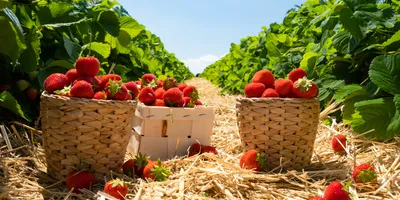Strawberries are among the most beloved fruits worldwide, known for their sweet flavor, vibrant color, and high nutritional value. While they can grow in a variety of climates, producing high-quality strawberries in hot weather can be challenging. Many traditional varieties struggle in semi-arid or tropical climates, making it essential to select the right cultivars.
A recent study published in the Journal of Agricultural Food and Chemistry has identified five heat-tolerant strawberry varieties that thrive in hot, dry regions like Texas. These findings offer valuable insights for growers in warm climates looking to optimize strawberry production.
Where Are the Best Strawberries Grown?
In the United States, California and Florida dominate commercial strawberry production. However, with the growing demand for local farmer’s markets and fresh produce, more regions are exploring strawberry cultivation. States like Texas, Arizona, and parts of the Southeast are looking for heat-tolerant strawberry varieties to expand production in hot climates.
Challenges of Growing Strawberries in Hot Weather
Strawberries thrive in cooler temperatures, making high heat, drought, and intense sunlight major obstacles for growers in warm regions. Key challenges include:
- Heat Stress: High temperatures can reduce fruit size and yield.
- Water Demand: Strawberries require consistent moisture but struggle with excess humidity.
- Flavor & Quality: Excessive heat can alter sugar levels and acidity, impacting taste.
Can Strawberries Grow in Hot Climates?
Yes, strawberries can grow in hot climates, but selecting the right variety is crucial. In a study conducted in Northwest Texas, researchers tested 10 strawberry cultivars, comparing spring-bearing and day-neutral varieties under semi-arid conditions. Their results provide important insights for growers in warm regions.
Key Findings from the Study
- Day-neutral varieties produced the lowest total berry weight per plant, making them less favorable for hot regions.
- Eight of the ten cultivars had survival rates of over 96% before the first harvest, proving their adaptability.
- Color intensity did not correlate with sweetness—redder berries tended to have higher citric acid levels, making them more tart.
- Flavor and aroma were the best indicators of consumer preference, with sugar content and aroma compounds playing a major role in perceived taste.
Heat-Tolerant Strawberry Varieties
Based on the study, the best strawberries to grow in hot climates include:
| Strawberry Variety | Growth Type | Flavor Profile | Best for Hot Climates |
|---|---|---|---|
| Albion | Day-neutral | Sweet & aromatic | ✅ Excellent |
| Sweet Charlie | Spring-bearing | Mildly sweet | ✅ Excellent |
| Camarosa | Spring-bearing | Rich & juicy | ✅ Excellent |
| Camino Real | Spring-bearing | Sweet & tart | ✅ Excellent |
| Chandler | Spring-bearing | Intense flavor | ✅ Excellent |
Can Strawberries Grow in Hot Weather? Best Practices for Success
If you want to grow strawberries in hot weather, follow these tips to improve yield, fruit quality, and plant health:
1. Choose the Right Variety
- Opt for spring-bearing varieties like Camarosa, Chandler, and Sweet Charlie, which perform better in warm regions.
- Avoid day-neutral varieties in extreme heat, as they produce lower berry weight per plant.
2. Provide Partial Shade
- While strawberries love sunlight, excessive heat can cause sunburn on berries.
- Use shade cloths or plant near taller crops to reduce direct sun exposure.
3. Maintain Consistent Moisture
- Drip irrigation is ideal to provide steady moisture without overwatering.
- Mulching with straw or organic matter helps retain soil moisture and keep roots cool.
4. Optimize Soil Conditions
- Use well-draining soil rich in organic matter.
- Maintain a soil pH between 5.5 and 6.5 for optimal growth.
5. Harvest at the Right Time
- In hot climates, strawberries may ripen faster than usual.
- Pick berries early in the morning to preserve their sweetness and firmness.
Conclusion: The Best Strawberries for Hot Climates
For those wondering, “Can strawberries grow in hot climates?”, the answer is yes—with the right varieties and care. The five best heat-tolerant strawberry cultivars—Albion, Sweet Charlie, Camarosa, Camino Real, and Chandler—offer excellent yield, flavor, and adaptability in warm environments.
By implementing proper irrigation, shade techniques, and soil management, farmers and home gardeners can successfully grow delicious, high-quality strawberries in hot weather. Whether you're growing strawberries in Texas, Florida, Arizona, or other warm climates, selecting heat-tolerant strawberry varieties will help ensure a successful harvest.











